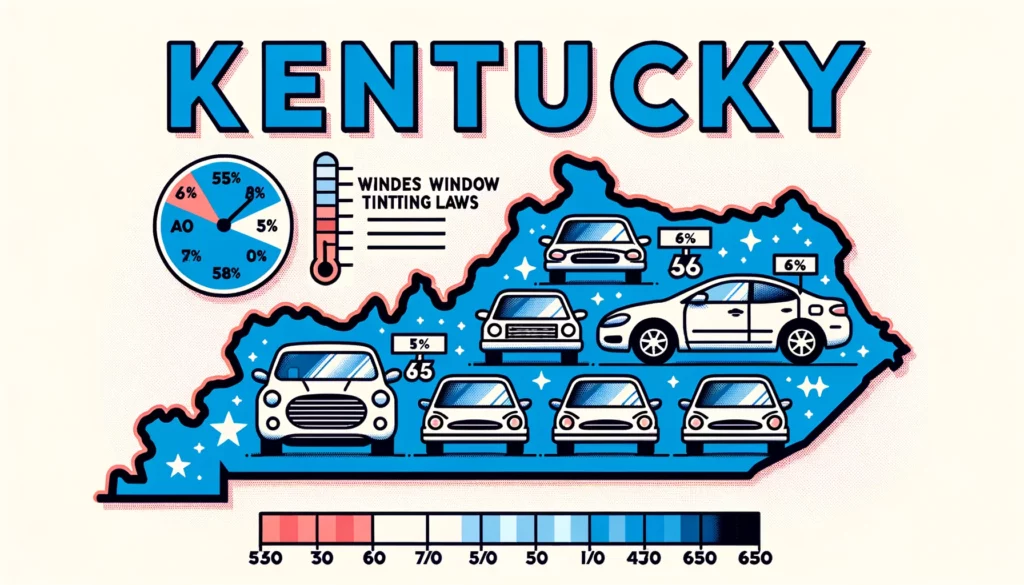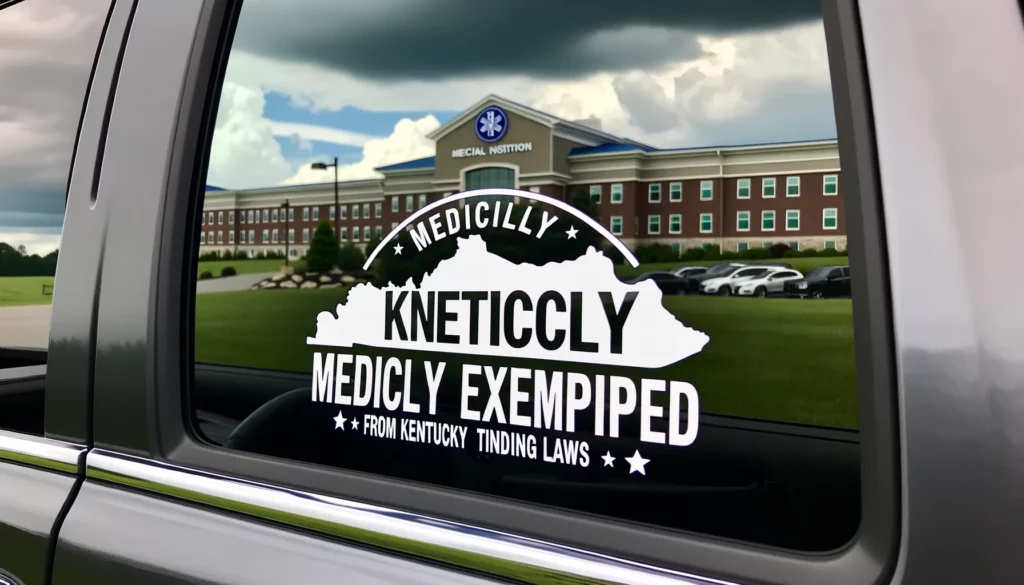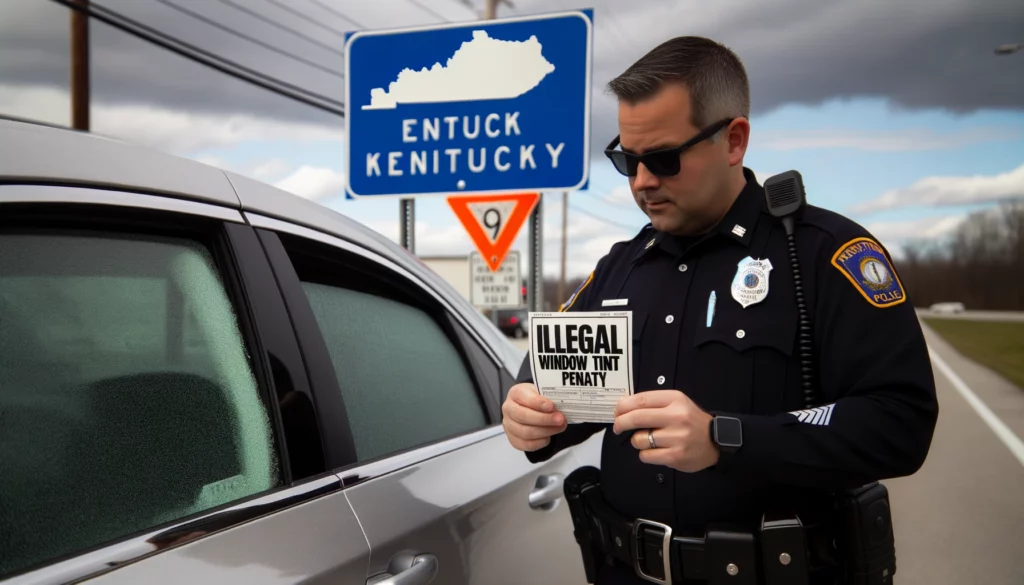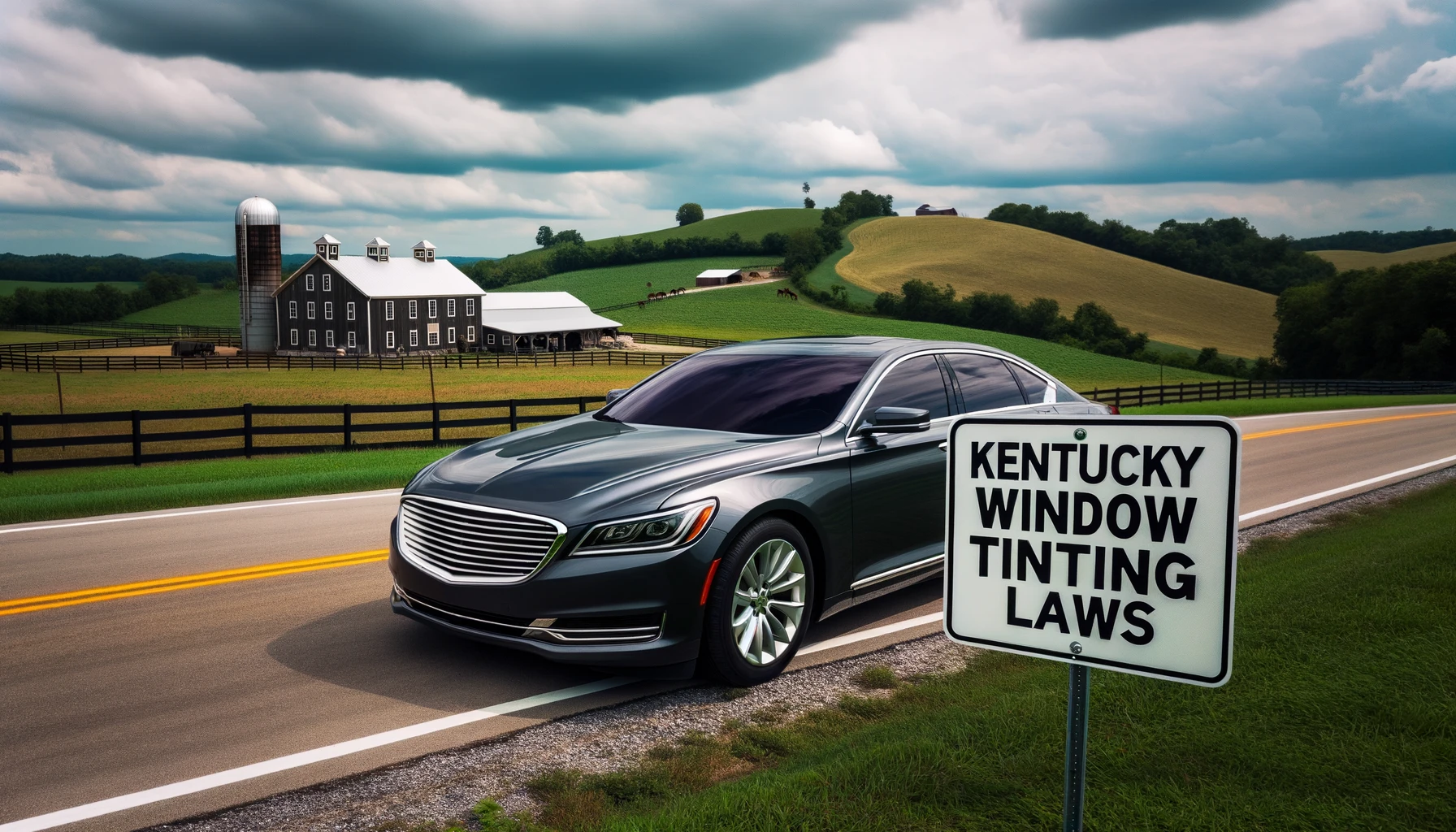Darkest legal tint for Sedans in Kentucky
- Windshield: Non-reflective tint is allowed above the manufacturer’s AS-1 line.
- Front Side windows: windows: Must allow more than 35% of light in.
- Back Side windows: Must allow more than 18% of light in.
- Rear window: Must allow more than 18% of light in.
Darkest legal tint for SUV and Vans in Kentucky
- Windshield: Non-reflective tint is allowed above the manufacturer’s AS-1 line.
- Front Side windows: windows: Must allow more than 35% of light in.
- Back Side windows: Must allow more than 18% of light in.
- Rear window: Must allow more than 18% of light in.
Kentucky Window Tinting Laws

Are you tired of the scorching Kentucky sun beating down on your car’s interior? Window tinting might be the solution you’re looking for. But before you rush to the nearest tint shop, it’s crucial to understand Kentucky’s window tinting laws to avoid fines and hassles down the road.
Let’s break it down, shall we?
What’s Legal?
Kentucky law allows non-reflective tint on the windshield above the manufacturer’s AS-1 line. For front side windows, the tint must allow more than 35% of light in. Moving to the back side windows and the rear window, they must allow more than 18% of light in. These regulations are applicable to both sedans and larger vehicles like SUVs and vans.
Why Do These Laws Exist?
The laws might seem restrictive, but they exist for good reasons. Proper visibility is crucial for road safety, especially during low-light conditions. Emergency responders need to see inside vehicles, ensuring everyone’s safety.
Avoiding the Legal Hassles
To avoid legal issues, it’s wise to have your window tint professionally installed. Professionals are aware of the legal limits and can ensure your tint complies with the law. Plus, professional installation means no bubbling or peeling, giving your car a sleek look while keeping you within legal boundaries.
DIY vs. Professional Installation
While DIY tinting kits are available, they often result in uneven tint, bubbles, and creases. These imperfections not only look bad but can also get you in trouble with the law. Investing in professional installation ensures a seamless, even tint that keeps you legal and stylish.
Medical Exemptions for Kentucky Tint Laws

A medical exemption is like a golden ticket in the world of window tinting laws. It grants individuals permission to have darker tint on their windows, a privilege not afforded to the average driver. This exemption recognizes that certain medical conditions make people highly sensitive to sunlight, causing discomfort or even harm. So, while others might be squinting through their lightly tinted windows, individuals with medical exemptions can enjoy the road in relative comfort and safety.
Eligibility and Documentation
Getting a medical exemption isn’t a walk in the park. Kentucky requires proper documentation from a licensed physician, clearly stating the medical condition and the necessity for darker window tint. This documentation is crucial and acts as the bridge between discomfort and relief on the road. Conditions like lupus, melanoma, or light sensitivity disorders can make someone eligible for this exemption, allowing them to enjoy a more tolerable driving experience.
How to Apply for a Medical Exemption
If you’re eligible, the next step is applying. The process involves submitting the necessary medical documentation to the appropriate state agency, typically the Kentucky Transportation Cabinet. It’s crucial to be thorough and accurate during this process, as any discrepancies might result in a rejection.
Benefits Beyond Comfort
While the immediate benefit of a medical exemption is obvious – enhanced comfort and protection – it also contributes to road safety. Individuals with light sensitivity conditions can drive more safely without the blinding glare of the sun impeding their vision. This not only protects them but also others on the road.
Window Film Certificates and Stickers in Kentucky
Think of them as your car’s tinting credentials. In Kentucky, every tinted window needs to be certified. These certificates are like the birth certificates for your car’s tint – they prove it’s legal, safe, and approved by the state. And where do these certificates go? On your car’s windows, of course, in the form of stickers. These stickers are the subtle badges of honor that declare your tint is within the legal limits.
Why Certificates Matter
Certificates and stickers aren’t just decorative. They serve a vital purpose. Law enforcement officers use them to quickly identify legal tinting. Without these, your tint might raise suspicion, and you might find yourself explaining your choice of window darkness. Having these certificates handy ensures a hassle-free drive, every time.
Getting the Right Certification
Getting the right certification involves choosing a professional tinting service that complies with Kentucky’s regulations. These experts know the legal limits, ensuring your tint is just dark enough to keep you cool and just light enough to keep you legal. Once your windows are tinted, the installer provides you with the necessary certificates and affixes the corresponding stickers to your windows.
What to Look for in the Stickers
Kentucky’s window tint stickers typically display important information. You’ll find details like the installer’s license number, the film manufacturer, and the film’s darkness level. Having this information on the sticker not only makes your car look cool but also ensures you’re always on the right side of the law.
Penalties or Ticket Cost for Illegal Window Tint in Kentucky

So, what happens if you cross the line and opt for a tint that’s too dark? Brace yourself for fines. Law enforcement officers in Kentucky take window tint violations seriously. If you’re caught with illegal tint, expect a citation. The ticket cost varies but can range from $25 to $100 for the first offense. Multiple offenses within a certain timeframe can lead to steeper fines, potentially doubling or tripling the original amount.
The Ripple Effect
Beyond the immediate hit to your wallet, illegal window tint can have other consequences. It might affect your insurance rates. Insurers often see violations as red flags for risky behavior, potentially leading to higher premiums. Moreover, if your tint is significantly darker than the legal limit, you might be asked to remove it and get it rechecked by law enforcement, adding to your expenses.
Avoiding the Hassle
The best way to avoid penalties and extra costs is to stay within the legal limits. If you’re unsure about the darkness level of your tint, it’s wise to consult a professional. They can measure the tint’s light transmittance and ensure it complies with state regulations, keeping you on the right side of the law.
Conclusion
In conclusion, understanding Kentucky’s window tinting laws is vital for a hassle-free driving experience. By adhering to the state regulations, you not only avoid fines but also ensure road safety and enjoy a comfortable ride. Stay within the legal limits, consult professionals if needed, and keep your windows both stylish and compliant. Drive safely!
Info About the State of Kentucky
Kentucky, located in the southeastern region of the United States, is known for its rich cultural heritage, picturesque landscapes, and famous contributions to bourbon, bluegrass music, and horse racing. The state’s capital is Frankfort, but its largest city is Louisville. Kentucky is renowned for the Kentucky Derby, a prestigious horse race held annually in Louisville.
The state is bordered by Illinois, Indiana, Ohio, West Virginia, Virginia, Tennessee, and Missouri. Its diverse geography includes rolling hills, fertile plains, and the Appalachian Mountains in the eastern part of the state. The Ohio River forms its northern border.
Kentucky’s economy is diverse, with industries such as manufacturing, healthcare, agriculture, and technology playing significant roles. The state is also a leading producer of coal, though its economy has been transitioning toward other sectors in recent years.
Kentucky is home to numerous natural attractions, including Mammoth Cave National Park, the world’s longest known cave system. The state’s outdoor enthusiasts enjoy activities like hiking, boating, and exploring the scenic Daniel Boone National Forest.
Furthermore, Kentucky is famous for its bourbon whiskey production. Many distilleries, including iconic names like Maker’s Mark and Woodford Reserve, offer tours and tastings, providing visitors with a glimpse into the state’s distilling heritage.
Culturally, Kentucky boasts a vibrant arts scene, with museums, theaters, and music festivals celebrating its unique heritage. The state’s culinary traditions feature comfort food like fried chicken, barbecue, and bourbon-infused delicacies.
In summary, Kentucky’s blend of natural beauty, cultural richness, and economic diversity makes it a fascinating state to explore and a unique part of the American tapestry.
Frequently Asked Questions
How much is a tint ticket in Kentucky?
The cost of a tint ticket in Kentucky can vary based on the specific circumstances and the discretion of the law enforcement officer. Generally, for the first offense of illegal window tint, fines can range from $25 to $100. Subsequent offenses within a certain timeframe may result in higher fines. It’s important to follow the state’s tinting laws to avoid fines and legal complications.
Are tinted windows illegal in Kentucky?
No, tinted windows are not illegal in Kentucky as long as they adhere to the state’s regulations. It’s essential to ensure that the tint on your car windows complies with the specific darkness limits outlined by Kentucky law to avoid legal issues.
What is the darkest legal tint in Kentucky?
In Kentucky, the darkest legal tint varies for different windows of a vehicle. For front side windows, the tint must allow more than 35% of light in. As for back side windows and the rear window, they must allow more than 18% of light in to comply with state regulations.
